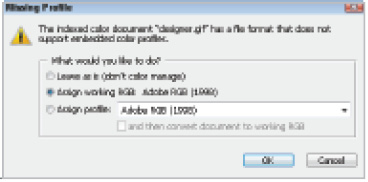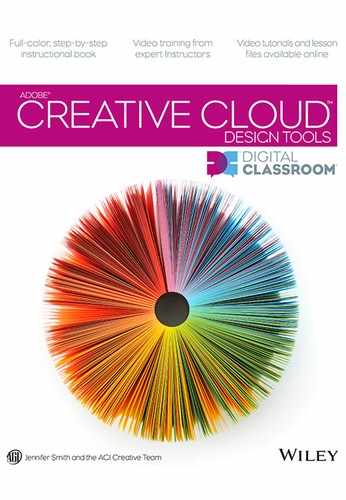Starting up
About Digital Classroom
Adobe Creative Cloud is the leading set of apps for creating print, web, and interactive content. It includes the perfect creative tools for designing and manipulating images, creating print and digital layouts, building and maintaining websites, and creating interactive and animated content. The Adobe Creative Cloud includes the tools you need to express your creative ideas.
The Adobe Creative Cloud Design Tools Digital Classroom helps you to understand the capabilities of these tools so you can get the most out of your applications and get up-and-running right away. You can work through all the lessons in this book, or complete only specific lessons that you need right now. Each lesson includes detailed, step-by-step instructions, along with lesson files, useful background information, and video tutorials.
Adobe Creative Cloud Design Tools Digital Classroom is like having your own expert instructor guiding you through each lesson while you work at your own pace. This book includes 24 self-paced lessons that let you discover essential skills, explore new features, and understand capabilities that save you time. You’ll be productive right away with real-world exercises and simple explanations. Each lesson includes step-by-step instructions, lesson files, and video tutorials, all of which are available on the Digital Classroom website: www.digitalclassroombooks.com/CC/DesignTools. The Adobe Creative Cloud Design Tools Digital Classroom lessons are developed by the same team of Adobe Certified experts that have previously created many of the official training guides for Adobe Systems.
The lessons in this book cover the essential skills for using the key design applications that are part of the Adobe Creative Cloud. To gain a more in-depth understanding of any of these software packages, turn to these Digital Classroom titles:
- • Dreamweaver CC Digital Classroom
- • Photoshop CC Digital Classroom
- • InDesign CC Digital Classroom
- • Illustrator CC Digital Classroom
- • Advanced Photoshop CC Digital Classroom
The Adobe Creative Cloud video applications are not covered in this book and are covered in the Adobe Premiere Pro Digital Classroom and the Adobe After Effects Digital Classroom books.
Prerequisites
Before you start the Adobe Creative Cloud Design Tools Digital Classroom lessons, you should have a working knowledge of your computer and its operating system. You should know how to use the directory system of your computer so that you can navigate through folders. You also need to understand how to locate, save, and open files, and you should also know how to use your mouse to access menus and commands.
Before starting the lessons files in the Adobe Creative Cloud Design Tools Digital Classroom, make sure that you have installed Creative Cloud. The software is sold separately, and not included with this book. You can use the free 30-day trial version of the Adobe Creative Cloud Design Tools Digital Classroom applications available at the adobe.com website, subject to the terms of its license agreement.
System requirements
Before starting the lessons in the Adobe Creative Cloud Tools Digital Classroom, make sure that your computer is equipped for running Adobe Creative Cloud, which you must purchase separately. These are the minimum system requirements for using most of the Adobe Creative Cloud applications. For the most current system requirements for each of the Creative Cloud applications, visit http://www.adobe.com/products/creativecloud/tech-specs.html.
Windows
- • Intel® Pentium® 4 or AMD Athlon® 64 processor (2GHz or faster)
- • Microsoft® Windows® 7 with Service Pack 1 or Windows 8
- • 1GB of RAM
- • 2.5GB of available hard-disk space for installation; additional free space required during installation (cannot install on removable flash storage devices)
- • 1024 × 768 display (1280 × 800 recommended) with OpenGL® 2.0, 16-bit color, and 512MB of VRAM (1GB recommended)*
- • Internet connection and registration are necessary for required software activation, membership validation, and access to online services.†
Mac OS
- • Multicore Intel processor with 64-bit support
- • Mac OS X v10.7 or greater
- • 1GB of RAM
- • 3.2GB of available hard-disk space for installation; additional free space required during installation (cannot install on a volume that uses a case-sensitive file system or on removable flash storage devices)
- • 1024 × 768 display (1280 × 800 recommended) with OpenGL 2.0, 16-bit color, and 512MB of VRAM (1GB recommended)*
- • Internet connection and registration are necessary for required software activation, membership validation, and access to online services.†
Note that 3D features are disabled with less than 512MB of VRAM.
Starting the Adobe Creative Cloud applications
As with most applications, Adobe Creative Cloud is launched by locating the application in your Programs folder (Windows) or Applications folder (Mac OS). If you are not familiar with starting the program, follow these steps to start the desired Adobe Creative Cloud application:
Windows
1 Choose Start > All Programs > Adobe Photoshop, Dreamweaver, InDesign, Flash, Fireworks, or Illustrator CC. If you have a Creative Cloud installed, you will navigate to that folder to locate the Photoshop, Dreamweaver, InDesign, Flash, Fireworks, or Illustrator CC folder. If you are using Windows 8, you might need to switch to the Desktop to view your Start menu and launch the Creative Cloud applications.
2 Close the Welcome Screen when it appears.
Mac OS
1 Open the Applications folder, and then open the Adobe Photoshop, Dreamweaver, InDesign, Flash, Fireworks, or Illustrator CC folder. If you have a Creative Cloud installed, you will open that folder to locate the Photoshop, Dreamweaver, InDesign, Flash, Fireworks, or Illustrator CC folder.
2 Double-click the Adobe Photoshop, Dreamweaver, InDesign, Flash, Fireworks, or Illustrator CC application icon.
3 Close the Welcome Screen when it appears.
 Menus and commands are identified throughout the book by using the
greater-than symbol (>). For example, the command to print a document is
identified as File > Print.
Menus and commands are identified throughout the book by using the
greater-than symbol (>). For example, the command to print a document is
identified as File > Print.
Resetting Adobe Photoshop CC preferences
When you start Adobe Photoshop, it remembers certain settings along with the configuration of the workspace from the last time you used the application. It is important that you start each lesson using the default settings so that you do not see unexpected results when working with the lessons in this book. The method described in the following steps restores Photoshop back to the original setting. If you have made changes to your Colors Settings and want to maintain them, follow the steps in the section, “Steps to reset default settings, but keep color settings.”
Steps to reset Adobe Photoshop CC preferences
1 If Photoshop is open, choose File > Exit (Windows) or Photoshop > Quit (Mac OS).
2 Press and hold the Ctrl+Alt+Shift keys (Windows) or Command+Option+Shift keys (Mac OS) simultaneously while launching Adobe Photoshop CC.
3 A dialog box appears verifying that you want to delete the Adobe Photoshop settings file. Release the keys, and then click OK.
Steps to reset default settings, but keep color settings
As you reset your preferences to the default settings, you might want to keep your color settings. This is important if you have created specific color settings, or work in a color-calibrated environment.
Use the following steps to reset your Adobe Photoshop CC preferences and save your color settings.
1 Launch Adobe Photoshop CC.
2 Choose Edit > Color Settings, and then click the Save button. The Save dialog box opens. Enter an appropriate name for your color settings, such as the date. Leave the destination and format unchanged, then click the Save button. The Color Settings Comment dialog box opens.
3 In the Color Settings Comment dialog box, enter a description for the color settings you are saving and then click OK. Click OK again in the Color Settings dialog box to close it. You have saved your color settings so they can be accessed again in the future.
4 Choose File > Quit to exit Adobe Photoshop CC.
5 Press and hold the Ctrl+Alt+Shift keys (Windows) or Command+Option+Shift keys (Mac OS) simultaneously when launching Adobe Photoshop CC. A dialog box appears verifying that you want to delete the Adobe Photoshop settings file. Release the keys and then click OK.
6 After Adobe Photoshop CC launches, choose Edit > Color Settings. The Color Settings dialog box appears.
7 From the Settings drop-down menu, choose your saved color settings file. Click OK. Your color settings are restored.
A note about color warnings
Depending upon how your Color Settings are configured, there might be times when you will receive a Missing Profile or Embedded Profile Mismatch warning. If you do receive Missing Profile and Embedded Profile Mismatch warnings, choose the Assign working option, or Convert document’s colors to the working space. What is determined to be your working space is what you have assigned in the Color Settings dialog box. Color Settings are discussed in more detail in Photoshop Lesson 4, “Painting and Retouching” and in Photoshop Lesson 5, “Color Correcting an Image.”

Missing color profile.

Mismatched color profile.
Resetting the Dreamweaver workspace
When you get to the Dreamweaver section of this book you can make certain that your panels and working environment are consistent. Do this by resetting your workspace at the start of each Dreamweaver lesson. To reset the Dreamweaver workspace, choose Window > Workspace Layout > Compact.
Resetting the Flash workspace
When you get to the Flash section of this book you can make certain that your panels and working environment are consistent. Do this by resetting your workspace at the start of each Flash lesson. To reset the Flash workspace, choose Window > Workspace > Reset ‘Essentials.’
Resetting Adobe Illustrator CC preferences
When you start Adobe Illustrator, it remembers certain settings along with the configuration of the workspace from the last time you used the application. It is useful for you to start each of the Adobe Illustrator lessons in this book using the default settings so that you do not see unexpected results. You can use the following steps to reset the Adobe Illustrator CC preferences.
In order to reset your preferences you will need to quit Illustrator and locate the preferences. In Windows and the Mac OS these are in two separate locations. If you are working on a Windows system you might need to change the folder’s view settings in order to find the preferences. Keep in mind that when you reset your preferences you lose saved colors, styles and other preferences that might be important to you. If you wish to save your preferences, rename them instead of deleting them; Illustrator will create all new preferences if it cannot locate the appropriately named folder.
Steps to resetting Windows preferences
1 Quit Adobe Illustrator CC.
2 In Windows, verify that you can find the hidden AppData folder by opening your Control Panel and typing Folder Options into the search text field in the upper-right of the Control panel dialog box.
3 When Folder Options appears, click Show hidden files and folders.
4 In the View tab of Folder Options click the radio box to select Show hidden files, folders and drives. Click OK.

In Windows, you might have to change your folders to show Hidden folders.
5 Select C:Usersuser nameAppDataRoamingAdobeAdobe Illustrator.
6 Select the
folder named Adobe Illustrator CC Settings. If you want
to save custom settings to restore at a later time,
rename this file
Adobe
Illustrator CC Settings folder_old.
7 If you want to delete the preferences and start with new clean preferences, delete the entire Adobe Illustrator CC Settings folder.
8 Relaunch Adobe Illustrator CC. Your preferences are back to the original settings.
Steps to resetting Mac OS preferences
1 Quit Adobe Illustrator CC.
2 Choose User > Library > Preference and select the Adobe Illustrator CC Settings folder.
3 Select the
folder named Adobe Illustrator CC Settings. If you want
to save custom settings to restore at a later time,
rename this file
Adobe Illustrator CC Settings
folder_old.
4 If you want to delete the preferences and start with new clean preferences, delete the entire Adobe Illustrator CC Settings folder.
5 Relaunch Adobe Illustrator CC. Your preferences are back to the original settings.
To restore custom settings, Quit Adobe Illustrator, and then delete the new AIPrefs file and restore the original name of the previous AIPrefs file.
Resetting the InDesign workspace and preferences
To make certain that your panels and working environment are consistent, you should reset your workspace at the start of each lesson. To reset your workspace, choose Window > Workspace > Typography. The selected workspace determines which menu items display, which panels display, and which options display within the panels. If menu items that are identified in the book are not displaying, choose Show All Menu Items from the menu in which you are working to locate them, or choose Window > Workspace > Advanced to show all panel options.
You can reset the settings for InDesign at the start of each lesson to make certain you match the instructions used in this book. To reset the InDesign preferences, start Adobe InDesign, and immediately press Shift+Alt+Ctrl (Windows) or Shift+Option+Command+Control (Mac OS). In the dialog box that appears, press OK to reset the preferences.
Fonts used in this book
Adobe Creative Cloud Design Tools Digital Classroom includes lessons that refer to fonts that were installed with your copy of the Adobe software. If you did not install the fonts, or have removed them from your computer, you might substitute different fonts for the exercises or re-install the software to access the fonts.
 If you receive a Missing Font warning, replace the font with one
available on your computer and proceed with the lesson.
If you receive a Missing Font warning, replace the font with one
available on your computer and proceed with the lesson.
Register your book
By registering your book you gain access to the most current lesson files, online access to the video tutorials contained on the DVD, and can receive notifications of updates. You can register your book at http://www.DigitalClassroomBooks.com/CC/DesignTools.
Loading lesson files
The Adobe Creative Cloud Design Tools book includes files that accompany the exercises for each of the lessons. These files are available for download at www.digitalclassroombooks.com/CC/DesignTools. You can download all the lessons at one time or you may choose to download and work with specific lessons.
For each lesson in the book, the files are referenced by the file name of each file. The exact location of each file on your computer is not used, since you might have placed the files in a unique location on your hard drive. We suggest placing the lesson files in the My Documents folder or the Desktop (Windows) or at the top level of your hard drive or on the Desktop (Mac OS).
Downloading and copying the lesson files to your hard drive:
1 Use your web browser, navigate to www.digitalclassroombooks.com/CC/DesignTools. Follow the instructions on the web page to download the lesson files to your computer.
2 On your computer, navigate to the location where you downloaded the files and right-click (Windows) the .zip file you downloaded, then choose Extract All or double-click on the .zip file (Mac OS).
The lesson files used in this book have been selected from the individual Digital Classroom books that cover each of the Creative Cloud applications in-depth. As such, the lesson names and numbers referenced in the book or video files do not always follow a complete sequence.
Working with the video tutorials
The www.digitalclassroombooks.com/CC/DesignTools site provides Adobe Creative Cloud Design Tools Digital Classroom book readers with video tutorials that enhance the content of this book. The videos use the popular Silverlight player for viewing on your desktop or notebook computer, or use iPad-compatible video if you are using an iPad to read an electronic version of this book. Most other ePub devices are not optimized for playing video, and you should use a notebook, desktop, or tablet computer for viewing the video tutorials if you are using a dedicated e-reader such as a nook, Kindle, kobo, or Sony e-reader. An internet connection is necessary for viewing the supplemental video files.
The videos enhance your learning as key concepts and instructions are discussed by the book’s authors. The video tutorials supplement the book’s contents, and do not replace the book. They are not intended to cover every item discussed in the book, but will help you gain a better or more clear understanding of topics discussed in many lessons of the book.
Additional resources
The Digital Classroom series goes beyond the training books. You can continue your learning online, with training videos, at seminars and conferences, and in-person training events.
On-demand video training from the authors
Comprehensive video training from the authors are available at DigitalClassroom.com. Find complete video training along with thousands of video tutorials covering Photoshop and related Creative Cloud apps along with digital versions of the Digital Classroom book series. Learn more at DigitalClassroom.com.
Training from the Authors
The authors are available for professional development training workshops for schools and companies. They also teach classes at American Graphics Institute, including training classes and online workshops. Visit agitraining.com for more information about Digital Classroom author-led training classes or workshops.
Additional Adobe Creative Cloud books
Expand your knowledge of creative software applications with the Digital Classroom book series. Books are available for most creative software applications as well as web design and development tools and technologies. Learn more at DigitalClassroomBooks.com.
Seminars and conferences
The authors of the Digital Classroom seminar series frequently conduct in-person seminars and speak at conferences, including the annual CRE8 Conference. Learn more at agitraining.com and CRE8summit.com.
Resources for educators
Visit digitalclassroombooks.com to access resources for educators, including instructors’ guides for incorporating Digital Classroom into your curriculum.
